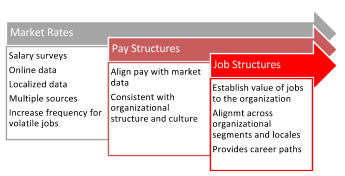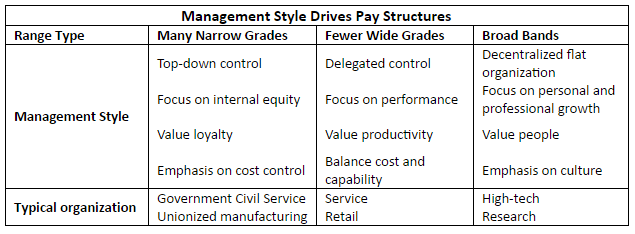
Your organization’s management style and values drive pay ranges. Hierarchical organizations use many narrow grades while a team-based flat organization may have very broad bands.
If you don’t align your compensation programs with your pay philosophy and strategy, your workforce will not be aligned to your company.
In a previous article, we wrote about how compensation philosophy, policy, and strategy drive organizational culture. Our main point was that transparency and open communication will drive a culture of trust.
Executing the strategy requires the same transparency and openness. People want to know about the mechanisms you use to value their jobs and reward performance. If they don’t have the answers, they will make assumptions based on how much they trust management.
Putting the compensation strategy in place requires a framework to define how your organization benchmarks  market rates, aligns pay ranges to the market, establishes the value of jobs, and manages equity across the organization.
market rates, aligns pay ranges to the market, establishes the value of jobs, and manages equity across the organization.
Market Rates
Most organizations benchmark pay against market rates using compensation surveys, BLS statistics, and online companies that collect data from employees. These studies enable you to evaluate market trends and labor availability based on two assumptions:
- Market rates rise and fall based on the scarcity of talent.
- Local rates reflect the local economy and demand for skills.
Using these data sources enables you to compare your current pay with market rates to help pinpoint areas where pay rates may make it difficult to attract the right talent. Or, you might overpay for skills that are no longer scarce. These data also enable your compensation team and business leaders to make better decisions about resource allocations and your competitive position.

Tips for Success
- Using surveys requires the expertise of a seasoned compensation analyst to fill in missing data. Companies structure and evaluate jobs differently, and the scope of duties varies. Some jobs don't seem to fit into any group. Any comp pro will tell you it is as much art as science.
- By using two or more sources, you can fill in missing information and can resolve differences and outliers. But beyond a small handful of sources, you will reach the point of diminishing returns.
- For most jobs, an annual benchmark may be sufficient, but critical skills and “hot” jobs require more attention. If a critical skill is in demand, salary rates can change so rapidly you will need to review the market at least monthly, or whenever you hire a new employee into the job.
Pay Structure
Pay structures give you a way to match compensation to market rates, manage costs, and handle the complexity of compensation planning.
Ranges enable you to decide how you will lag, match, or lead the market. For example, your philosophy might be that to be a competitive leader, your company will lead the market by 15%. This means that the midpoint of the pay range will be market + 15%, and that a performing, seasoned employee should be at or above the midpoint.
Tips for Success
- How you approach designing salary structures depends on your organization, but it must be consistent with your culture and your compensation philosophy. If you say will to lead the market, your salary structures must reflect that, or you risk alienating your people. If your philosophy is to lag the market, be prepared to say why.
- Transparency and communication are essential to organizational success. Communicate the why and how of the design.
Job Structures
Job structure or job leveling is the process of evaluating positions to determine their value to the organization, and it is the primary tool for determining job equity.
Creating a common language and comparisons across the organization make internal movement easier. For global organizations, a consistent structure across the organization makes career mobility easier, where companies can institute career paths that cross boundaries.
- Ranking or job comparison uses subjective analysis by an “expert” committee to assign a ranking or a position on a scale. Some organizations use nominal group technique or paired comparisons.
- Most government agencies use grading or grade/step systems. The organization assigns many narrow pay grades and experts place the jobs into the correct pay grade. Step increases compensate for length of service.
- Most private sector organization use point factor systems where they group jobs by factors and assign weights and values to each factor. The number of points determines the grade.
- Factor comparison uses a set of benchmark jobs and compares the using common factors such as physical effort, mental effort, the scope of responsibility, working conditions, and the education and experience required to attain proficiency.
Most organizations use several of these methods for different employee groups such as executives, and different methods for union and non-union employees.
Tips for Success
- Organizations with narrow grades and rigid policies manage employee concerns by implementing a formal process for individuals to dispute compensation decisions. That could be useful in any organization where open communication is lacking.
- Explain how and why you make decisions and communicate it in language everyone can understand. Make it so easy you need not explain it, then prepare to explain it. Some people need more reassurance.
Consistency, transparency, and communication are the main components of a successful compensation program. When it comes pay, conversation matters more than cash.
Pixentia is a full-service technology company dedicated to helping clients solve business problems, improve the capability of their people, and achieve better results.


